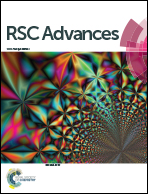Effect of doping indium into a Bi2Te3 matrix on the microstructure and thermoelectric transport properties†
Abstract
Indium (In) as an unconventional doping element for Bi2Te3 is applied in this work to investigate the effect of In doping on the microstructure and thermoelectric transport properties of Bi2Te3-based alloys prepared via a unique high-pressure method (high pressure and high temperature, HPHT). The synthesis time of the sample is acutely shortened compared with conventional preparation methods. Doping In into a Bi2Te3 matrix can induce multiple textures and microstructures, effectively scattering different frequency phonons. Additionally, the electrical transport properties are also significantly modulated due to the role of In atoms as electron donors. As a result, the lattice thermal conductivity and electrical resistivity are dramatically reduced, in particular a decrease of 64–54% in 305–585 K of the lattice thermal conductivity of the samples with In content from 1 to 2 at%. An acceptable ZT value of 0.65 at 385 K is achieved from the as-prepared Bi1.9In0.1Te3 bulk materials with In as a dopant in the Bi2Te3 matrix.


 Please wait while we load your content...
Please wait while we load your content...